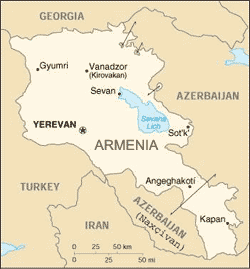One of the most tragic episodes of the World War I era involved the Armenian population living in what today is eastern Turkey. Many authorities believe that their treatment at the hands of the Turkish government amounted to the 20th century’s first exercise in genocide.
 The Armenian people had long occupied the area south of the Caucasus Mountains, but had fared badly at the hands of the Persians and later the Ottomans. Different from the Turkish population in language and religion, the Armenians had long agitated for political autonomy. By the early 20th century, the Armenian population in Turkey had become split. The wealthier communities in the west were generally loyal supporters of the Ottoman government and tended to support the Central Powers when the war began in 1914. The less prosperous Armenians, who lived in the traditional homelands in the east, tended to look to the Armenian Orthodox Church and the Russian Czar as their protectors and were sympathetic to the Allies in the war.
The Turkish government viewed all Armenians with suspicion and instituted programs of relocation and mass murder. Beginning in June 1915, non-Muslim peoples were forced to move away from areas deemed to have military sensitivity. Hundreds of thousands of Armenians were forced to march to new homes, some to the Syrian desert, others to Mesopotamia. Little preparation had been made for this exodus and the toll from exhaustion, disease and starvation was staggering. In other instances, bands of Turks and Kurds descended upon Armenian villages and slaughtered entire populations.
The Armenian people had long occupied the area south of the Caucasus Mountains, but had fared badly at the hands of the Persians and later the Ottomans. Different from the Turkish population in language and religion, the Armenians had long agitated for political autonomy. By the early 20th century, the Armenian population in Turkey had become split. The wealthier communities in the west were generally loyal supporters of the Ottoman government and tended to support the Central Powers when the war began in 1914. The less prosperous Armenians, who lived in the traditional homelands in the east, tended to look to the Armenian Orthodox Church and the Russian Czar as their protectors and were sympathetic to the Allies in the war.
The Turkish government viewed all Armenians with suspicion and instituted programs of relocation and mass murder. Beginning in June 1915, non-Muslim peoples were forced to move away from areas deemed to have military sensitivity. Hundreds of thousands of Armenians were forced to march to new homes, some to the Syrian desert, others to Mesopotamia. Little preparation had been made for this exodus and the toll from exhaustion, disease and starvation was staggering. In other instances, bands of Turks and Kurds descended upon Armenian villages and slaughtered entire populations.
 The treatment of the Armenians was not unknown in the outside world. The Allied governments and even Germany issued protests, but the Turkish government was intent on cleansing their lands of all Armenian influence. Persecution continued into the early 1920s. For years afterward, parents in the West would evoke images of starving Armenians as a means to encourage their children to clean their plates.
It is impossible to assign accurate numbers to the slaughter. Reports provided by Armenian groups are usually regarded by historians as too high, but the official Turkish numbers appear too low. Mid-range figures indicate that perhaps between 600,000 and one million Armenians died during this period, out of a pre-war population estimated at 1.5 million.
The treatment of the Armenians was not unknown in the outside world. The Allied governments and even Germany issued protests, but the Turkish government was intent on cleansing their lands of all Armenian influence. Persecution continued into the early 1920s. For years afterward, parents in the West would evoke images of starving Armenians as a means to encourage their children to clean their plates.
It is impossible to assign accurate numbers to the slaughter. Reports provided by Armenian groups are usually regarded by historians as too high, but the official Turkish numbers appear too low. Mid-range figures indicate that perhaps between 600,000 and one million Armenians died during this period, out of a pre-war population estimated at 1.5 million.